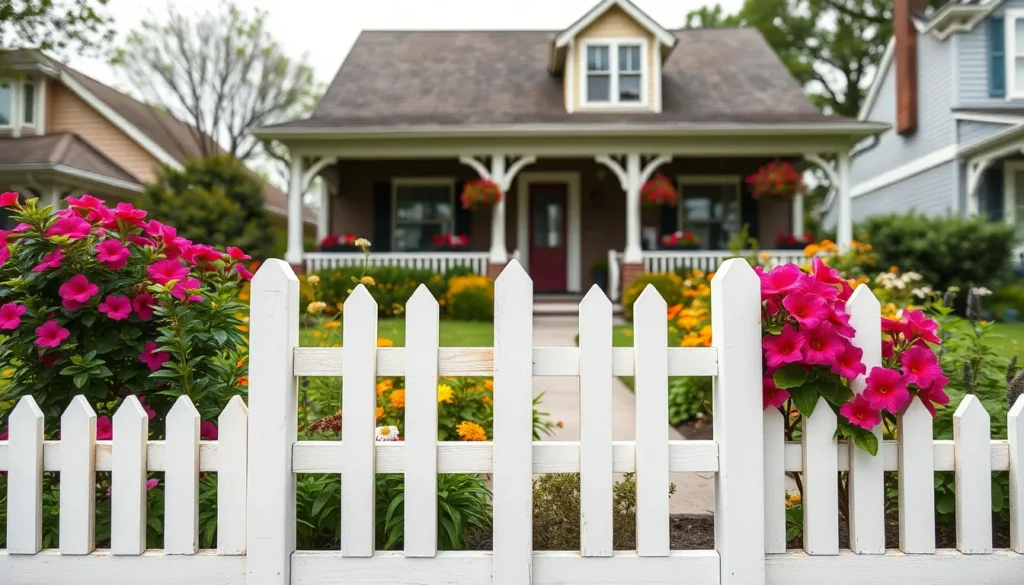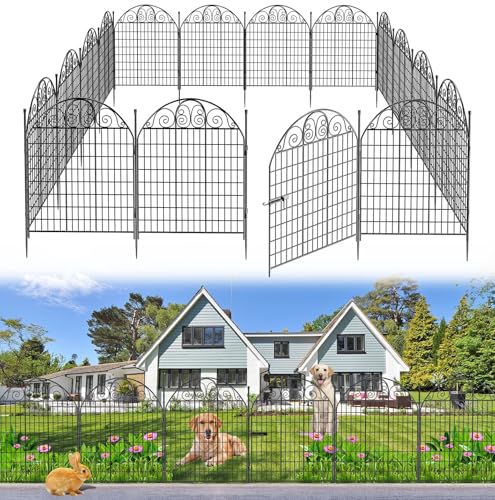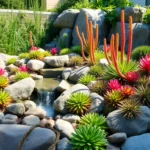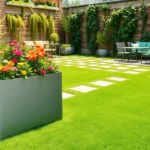Creating the perfect front garden fence transforms your home’s curb appeal while providing essential privacy and security. We understand that choosing the right fencing style can feel overwhelming with countless materials, heights, and designs available in today’s market.
Whether you’re looking to define property boundaries, keep pets safely contained, or simply enhance your industry’s aesthetic appeal, the right fence makes all the difference. From classic picket fences that evoke timeless charm to modern horizontal slats that create sleek contemporary lines, we’ll explore options that suit every style preference and budget.
Your front garden deserves a fence that complements your home’s architecture while meeting your practical needs. We’ve compiled innovative ideas that’ll help you create an inviting entrance that neighbors will admire and potential buyers will love.
Classic Wooden Fence Ideas for Timeless Appeal
Wooden fences remain the gold standard for front garden boundaries, offering warmth and character that never goes out of style. We’ve compiled the most enduring designs that enhance your home’s curb appeal while maintaining their classic charm.
Traditional Picket Fencing
Traditional picket fences create the quintessential American front yard aesthetic with their evenly spaced vertical slats and charming white finish. We recommend installing 3 to 4 foot high picket panels to maintain visibility while defining your property boundaries clearly. Standard picket spacing ranges from 2 to 4 inches apart, allowing air circulation while keeping larger pets contained safely.
Customization options for picket fencing include pointed, rounded, or decorative tops that add personality to your front garden entrance. We’ve seen homeowners choose cedar, pine, or pressure treated lumber depending on their budget and maintenance preferences. White paint remains the most popular choice, though natural wood stains and soft pastels like sage green or pale blue create distinctive looks.
Installation considerations include proper post spacing at 6 to 8 foot intervals to ensure structural integrity and longevity. We suggest using concrete footings for gate posts and corner installations to prevent sagging over time.
Cedar Privacy Panels
Cedar privacy panels offer complete seclusion while maintaining natural beauty through their tight board construction and rich wood grain patterns. We install these panels at heights ranging from 4 to 6 feet, depending on local regulations and your privacy needs. The natural oils in cedar wood provide built in resistance to insects, rot, and weather damage without chemical treatments.
Panel styles include board on board, solid tongue and groove, and horizontal slat configurations that suit different architectural themes and personal preferences. We’ve found that vertical board installations create height illusion for smaller front yards, while horizontal designs emphasize width and modern appeal.
Maintenance requirements for cedar panels involve annual cleaning and optional staining to preserve the wood’s natural color and protection properties. Weather exposure causes cedar to develop a silvery gray patina naturally, which many homeowners find attractive as an aging characteristic.
Rustic Split Rail Designs
Split rail fencing delivers countryside charm with minimal material requirements using horizontally stacked rails between sturdy wooden posts. We typically install 2 or 3 rail configurations depending on your containment needs and aesthetic preferences. This style works exceptionally well for larger front yards and rural or suburban settings.
Material choices include cedar, oak, and pine split rails that provide different durability levels and appearance characteristics over time. We recommend cedar for its natural weather resistance, while oak offers superior strength for high traffic areas. Pine presents the most budget friendly option with proper maintenance and treatment.
Design variations incorporate decorative post caps, wire mesh backing, or climbing plant supports that enhance functionality without compromising the rustic appearance. We’ve installed cross buck gates and matching mailbox posts to create cohesive front yard themes that complement farmhouse and cottage style homes.
Modern Metal Fencing Solutions for Contemporary Homes
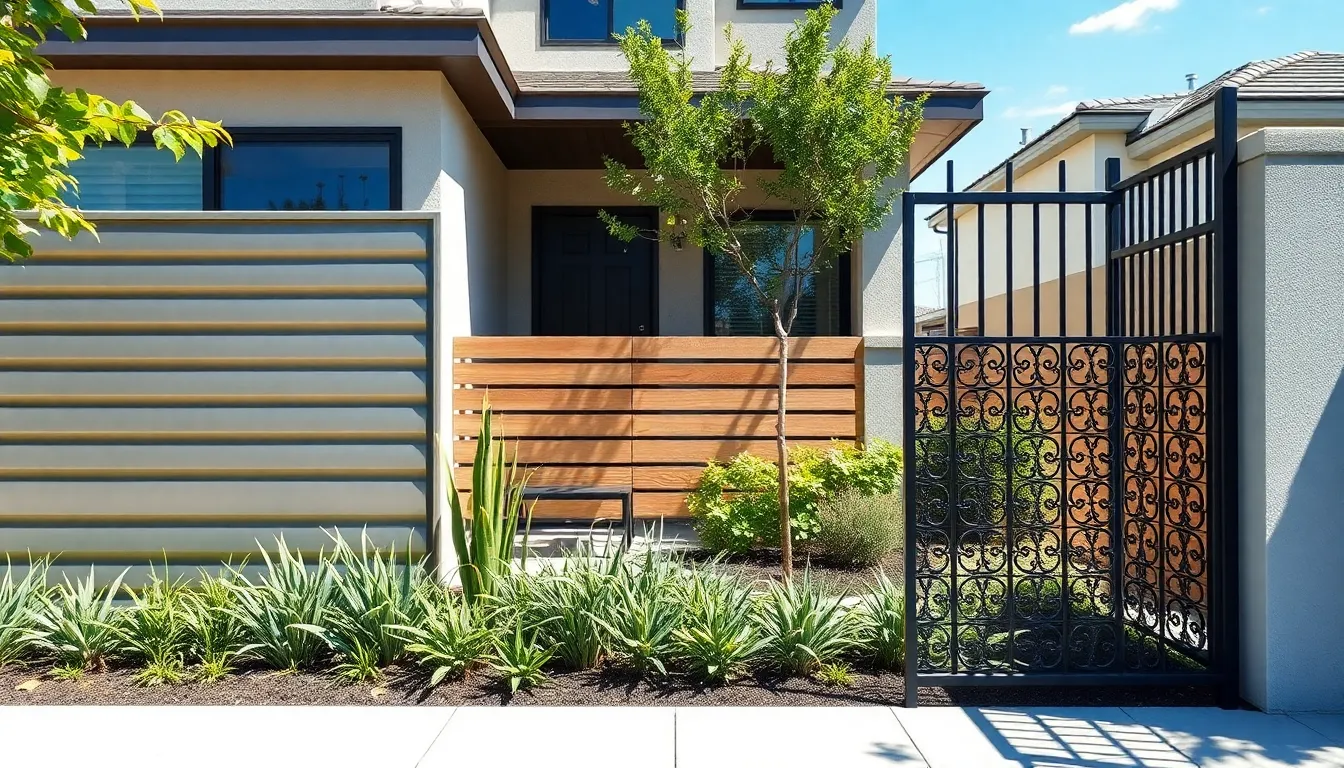
We’ve moved beyond traditional materials to explore cutting edge metal options that perfectly complement today’s architectural styles. Contemporary homeowners increasingly choose metal fencing for its unmatched durability and sophisticated appearance.
Sleek Aluminum Slat Panels
Aluminum slat panels deliver the perfect balance of modern aesthetics and practical functionality for front gardens. These smooth, flat slats create clean horizontal lines that complement contemporary home designs beautifully. We love how lightweight aluminum makes installation easier while its natural corrosion resistance ensures decades of maintenance free performance.
The sleek profile of these panels works exceptionally well for properties with minimalist architecture. Spacing between slats can be customized to control privacy levels while maintaining visual flow. Colors range from classic black and white to bronze and charcoal finishes that coordinate with modern exterior palettes.
Decorative Wrought Iron Options
Wrought iron fencing combines impressive strength with elegant design possibilities that enhance any contemporary property. We appreciate how this material allows for intricate patterns and ornate details that create stunning focal points. Custom fabrication options mean homeowners can match their fence design to existing architectural elements.
These durable installations withstand harsh weather conditions while developing an attractive patina over time. Ornamental scrollwork, geometric patterns, and artistic flourishes transform functional barriers into decorative statements. Professional powder coating in various colors protects the metal while complementing modern color schemes.
Industrial Steel Grid Designs
Steel grid designs bring bold industrial aesthetics to contemporary front gardens through their distinctive geometric patterns. These frameworks feature steel rods or bars arranged in precise grid formations that create striking visual impact. We find these designs particularly effective for modern homes with clean architectural lines.
The functional appeal of steel grids extends beyond aesthetics to provide excellent security and visibility. Grid spacing can be adjusted to meet exact privacy needs while maintaining an open, welcoming appearance. Galvanized or powder coated finishes protect against corrosion while offering color options that enhance modern landscapes.
Natural Stone and Masonry Fence Concepts
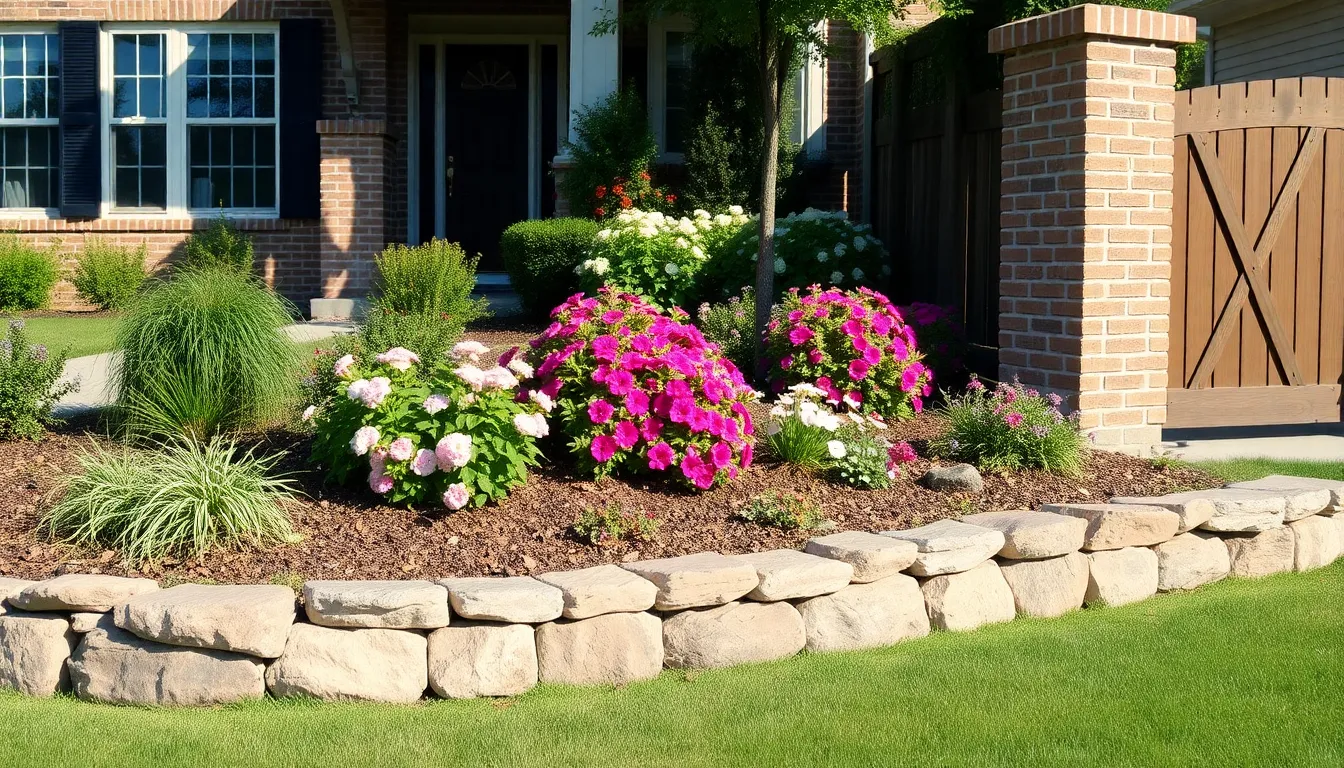
Stone and masonry fencing options bring timeless elegance to front gardens while offering exceptional durability. We’ll explore three distinctive approaches that combine natural materials with practical functionality.
Stacked Stone Retaining Walls
Stacked stone retaining walls provide both structural support and rustic charm to front garden landscapes. We recommend using natural fieldstone or quarried limestone blocks that create organic, flowing lines along property boundaries. These walls work particularly well on sloped terrain where they serve dual purposes of erosion control and visual definition.
Installation requires proper foundation preparation with compacted gravel base extending below frost line. We suggest incorporating drainage systems behind taller walls to prevent water buildup and structural issues. The natural gaps between stones create perfect planting pockets for cascading flowers like alyssum or creeping phlox.
Stone selection significantly impacts both appearance and cost, with local materials typically offering the best value. We’ve found that walls between 2 to 4 feet high strike the ideal balance between privacy and neighborhood friendliness. Adding capstone finishing across the top provides a polished appearance while protecting the wall structure from weather damage.
Brick Pillar Combinations
Brick pillars combined with decorative fencing sections create classic, timeless front garden boundaries. We design these features using sturdy brick columns spaced 6 to 8 feet apart, connected by wood, metal, or composite panels that complement the home’s architectural style.
The pillars themselves can incorporate decorative elements like stone caps, metal finials, or integrated lighting fixtures for enhanced curb appeal. We recommend using matching mortar colors and brick styles that coordinate with existing home exterior materials. Standard pillar dimensions range from 12 to 18 inches square, providing adequate structural support for attached fencing sections.
Construction requires concrete footings extending below frost line to prevent shifting and cracking. We suggest incorporating electrical conduit during pillar construction for future lighting installations. The combination approach allows homeowners to achieve substantial visual impact while controlling material costs compared to full masonry walls.
Gabion Wire and Rock Features
Gabion fencing involves wire cages filled with rocks or stones that deliver natural, earthy aesthetics while providing privacy and security. We use galvanized steel mesh containers typically measuring 3 feet wide by 1 to 3 feet high, filled with locally sourced stone materials ranging from river rock to crushed granite.
The wire cage construction allows for creative customization through rock selection and arrangement patterns. We recommend using stones sized between 4 to 8 inches for optimal filling and visual appeal. The open structure permits partial plant growth integration, creating living fence elements that blend seamlessly with garden landscapes.
Installation proves relatively straightforward, requiring level ground preparation and proper corner bracing for stability. We’ve observed that gabion fences perform exceptionally well in areas with drainage concerns since water flows freely through the stone fill. The modular design allows for easy height adjustments and future modifications as garden needs evolve.
Creative Mixed Material Fence Designs
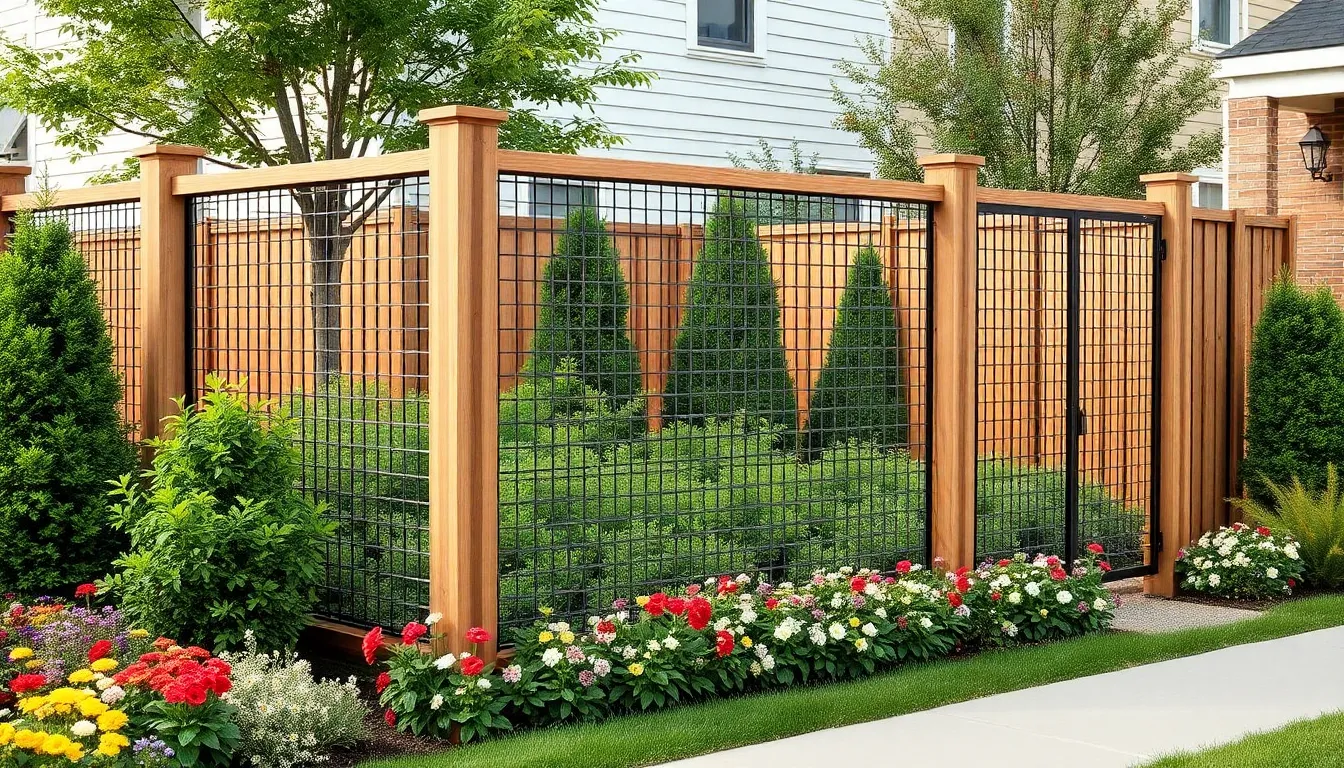
Mixed material fences combine different textures and colors to create visual interest while maintaining cohesion with your home’s architecture. These innovative approaches offer versatile options for homeowners seeking practical, beautiful, and harmonious front garden fencing answers.
Wood and Metal Hybrid Styles
Modern hog wire fences with wood posts and rails blend the warmth of natural materials with the durability and contemporary appeal of metal. These designs allow clarity and a sense of openness while maintaining a stylish, updated look that’s adaptable for various architectural styles.
Customize these hybrid fences in height and finish to suit different design needs, from 3 foot garden borders to 6 foot privacy screens. The combination works particularly well with ranch style homes and contemporary designs where you want to maintain sight lines while defining boundaries.
Install wooden posts first, then attach horizontal rails before securing the hog wire panels for the most stable construction. This approach provides the structural integrity of wood with the low maintenance benefits of metal mesh.
Stone Base with Wooden Tops
Stone foundations topped with wooden elements create robust, visually appealing fences that provide a solid base for privacy and security. This design approach offers the permanence of masonry with the warmth and charm that wooden components bring to your front garden.
Match the stone materials to your home’s exterior elements, such as choosing fieldstone bases that complement a natural stone facade or brick foundations that echo your home’s architectural details. The wooden tops can be customized with picket styles, horizontal slats, or decorative panels.
Build the stone base 18 to 24 inches high to establish a strong foundation, then attach wooden fence panels or individual boards to create your desired height and privacy level. This combination helps tie together different materials from your home’s exterior while creating a distinctive property boundary.
Glass Panel Integration
Glass panels integrated into front garden fences offer modern, transparent boundaries that provide unobstructed views while subtly defining property lines. These contemporary elements work exceptionally well in sleek industry designs where you want to maintain visual flow between spaces.
Pair glass panels with metal or wood frames to enhance durability and style, creating striking combinations that complement modern architecture. The transparent nature of glass allows you to showcase beautiful landscaping while still establishing clear property boundaries.
Consider tempered glass panels for safety and weather resistance, mounting them in sturdy aluminum or steel frames that can withstand wind loads and temperature changes. These installations require professional expertise but deliver sophisticated results that increase your home’s curb appeal and value.
Low-Maintenance Vinyl and Composite Options
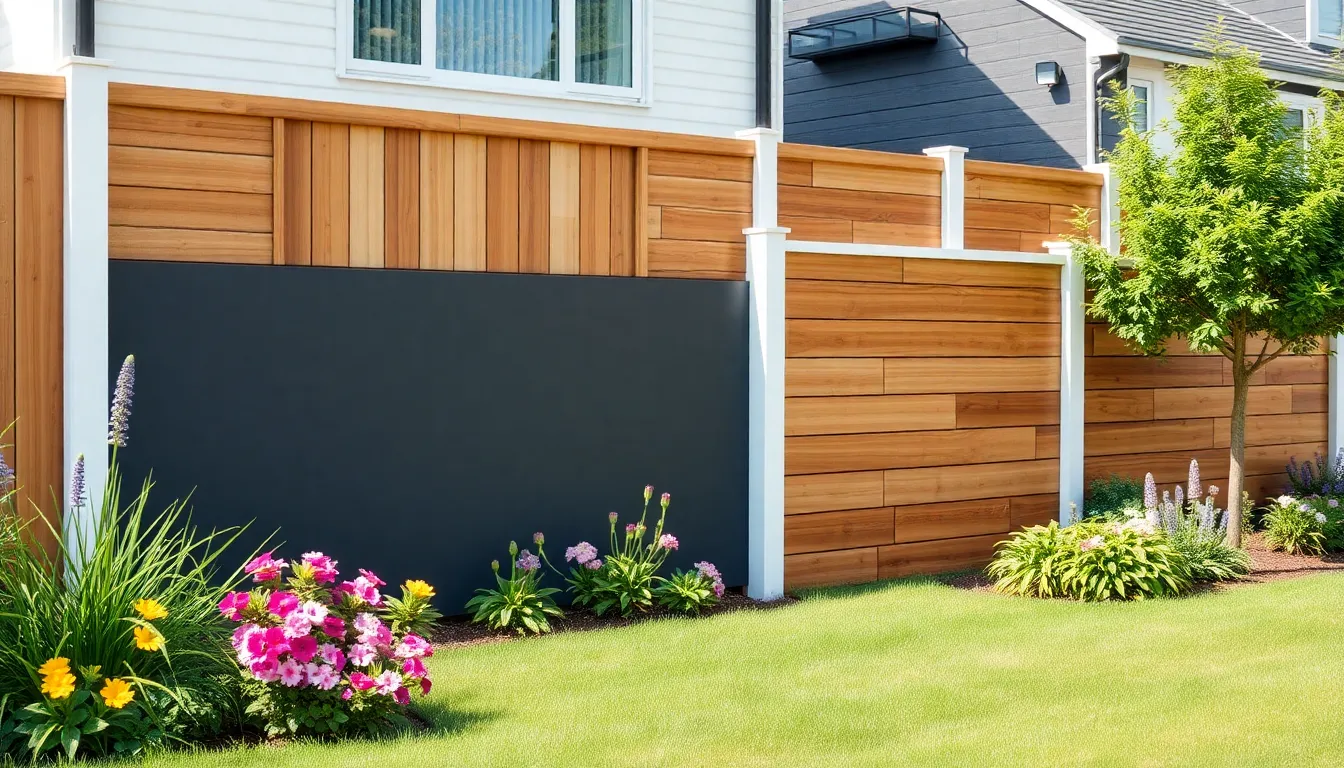
Modern homeowners increasingly choose vinyl and composite fencing answers that eliminate the hassle of regular upkeep while delivering lasting beauty. These innovative materials provide the perfect balance of durability and aesthetic appeal for front gardens.
PVC Privacy Screening
PVC privacy screens offer exceptional versatility for creating secluded garden spaces without sacrificing style. We recommend these panels for homeowners who want immediate privacy while maintaining a clean, contemporary appearance that complements modern architecture.
Installation becomes remarkably straightforward with PVC screening systems that connect directly to existing posts or standalone frames. Most panels feature interlocking designs that allow for quick assembly without specialized tools or professional assistance.
Weather resistance sets PVC apart from traditional materials, as these screens withstand UV rays, moisture, and temperature fluctuations without warping or discoloration. The material maintains its structural integrity for decades, making it an excellent investment for long term property enhancement.
Composite Board Alternatives
Composite boards deliver the authentic wood appearance that many homeowners desire while eliminating traditional maintenance requirements. These engineered materials combine wood fibers with durable plastics to create fencing that mimics natural grain patterns and textures.
Durability surpasses natural wood alternatives significantly, as composite materials resist rot, insect damage, and weathering that typically plague organic fencing options. We’ve found that composite fences maintain their appearance for 20 to 30 years with minimal intervention.
Versatility in design allows composite boards to replicate various wood species, from classic cedar tones to rich mahogany finishes. Many manufacturers offer textured surfaces that feel remarkably similar to natural wood when touched.
Maintenance-Free Color Choices
Color retention technology ensures that vinyl and composite fences maintain their original appearance throughout their lifespan without painting or staining. We particularly appreciate how these materials resist fading even under intense sunlight exposure.
Available options span from traditional white and tan shades to contemporary gray and black finishes that complement modern home designs. Many manufacturers now offer wood grain textures in multiple color variations, providing authentic appearance without ongoing maintenance demands.
Factory applied finishes penetrate the material completely, preventing chips and scratches from exposing different colored substrates underneath. This manufacturing process ensures consistent coloration that won’t require touch ups or complete refinishing over time.
Decorative Fence Ideas for Enhanced Curb Appeal
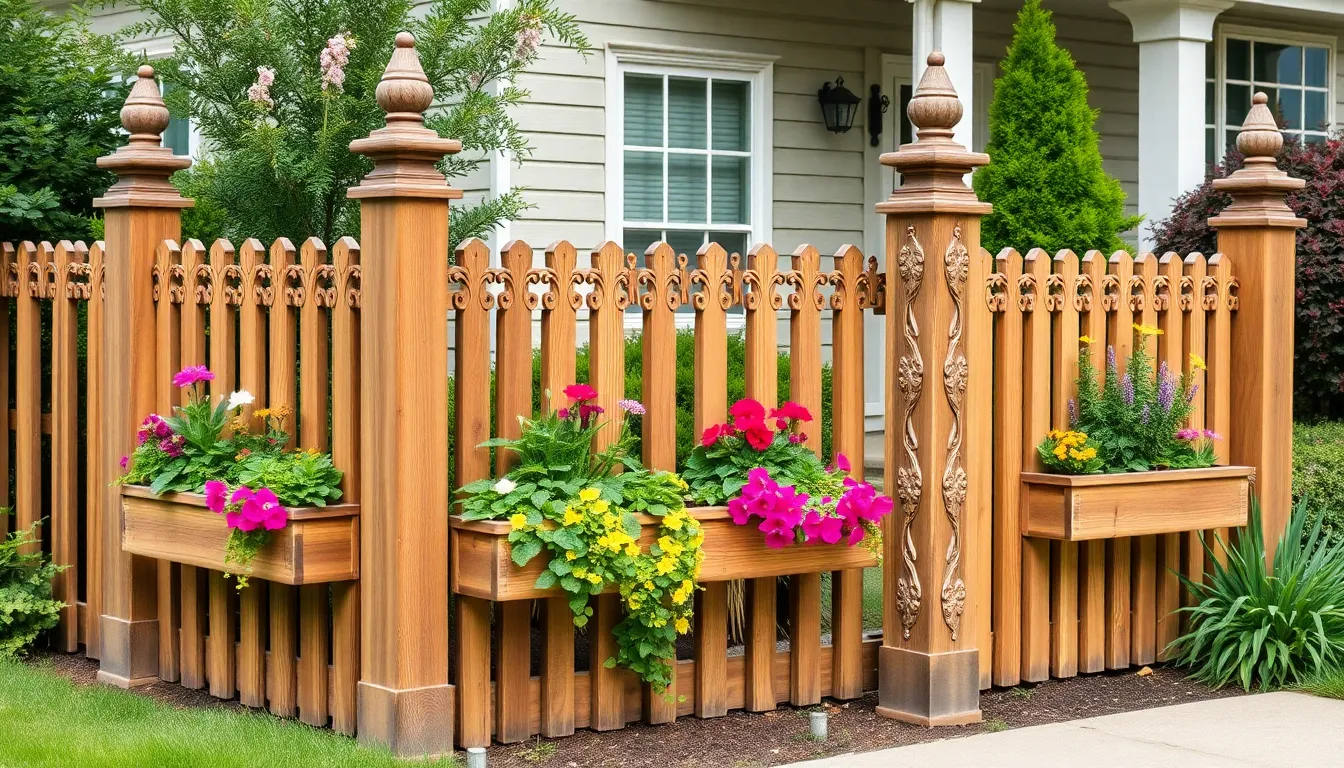
Decorative elements transform ordinary front garden fences into stunning focal points that significantly boost your home’s curb appeal. We’ll explore three popular enhancement techniques that combine beauty with functionality.
Lattice Top Additions
Lattice panels create visual interest when added atop traditional solid fencing structures. We recommend pairing these open lattice tops with lower solid panels to maintain security while introducing an elegant architectural element that catches the eye.
Adding lattice toppers allows climbing plants like jasmine, clematis, or morning glories to flourish naturally. These plant combinations create a cottage garden atmosphere that welcomes visitors with lush greenery and seasonal blooms.
Installation requires careful measurement to ensure proper proportions between solid and lattice sections. We suggest keeping the lattice portion between 12 to 18 inches tall for optimal visual balance while maintaining the fence’s primary function.
Carved Post Details
Carved wooden posts serve as striking focal points that elevate standard fencing into custom architectural features. We often see homeowners choose finials, scrollwork, or geometric patterns that complement their home’s existing design elements.
Customization options include traditional acorn caps, decorative ball tops, or intricate Victorian style flourishes. These carved details transform plain fence posts into artistic statements that reflect personal style preferences.
Professional carving ensures durability and weather resistance when properly sealed and maintained. We recommend selecting hardwood species like cedar or redwood for their natural resistance to moisture and insect damage.
Integrated Planter Boxes
Built in planter boxes offer seamless integration between landscaping and fencing structures. We’ve noticed these designs create stunning visual continuity by allowing flowers, herbs, and small shrubs to grow directly within the fence framework.
Strategic placement of planter sections breaks up long fence runs while providing opportunities for seasonal color changes. These integrated gardens soften hard fence lines and create depth along property boundaries.
Drainage considerations become crucial for successful planter box integration. We recommend installing proper drainage systems and selecting appropriate soil mixes to ensure plant health while protecting the fence structure from moisture damage.
Budget-Friendly DIY Front Garden Fencing
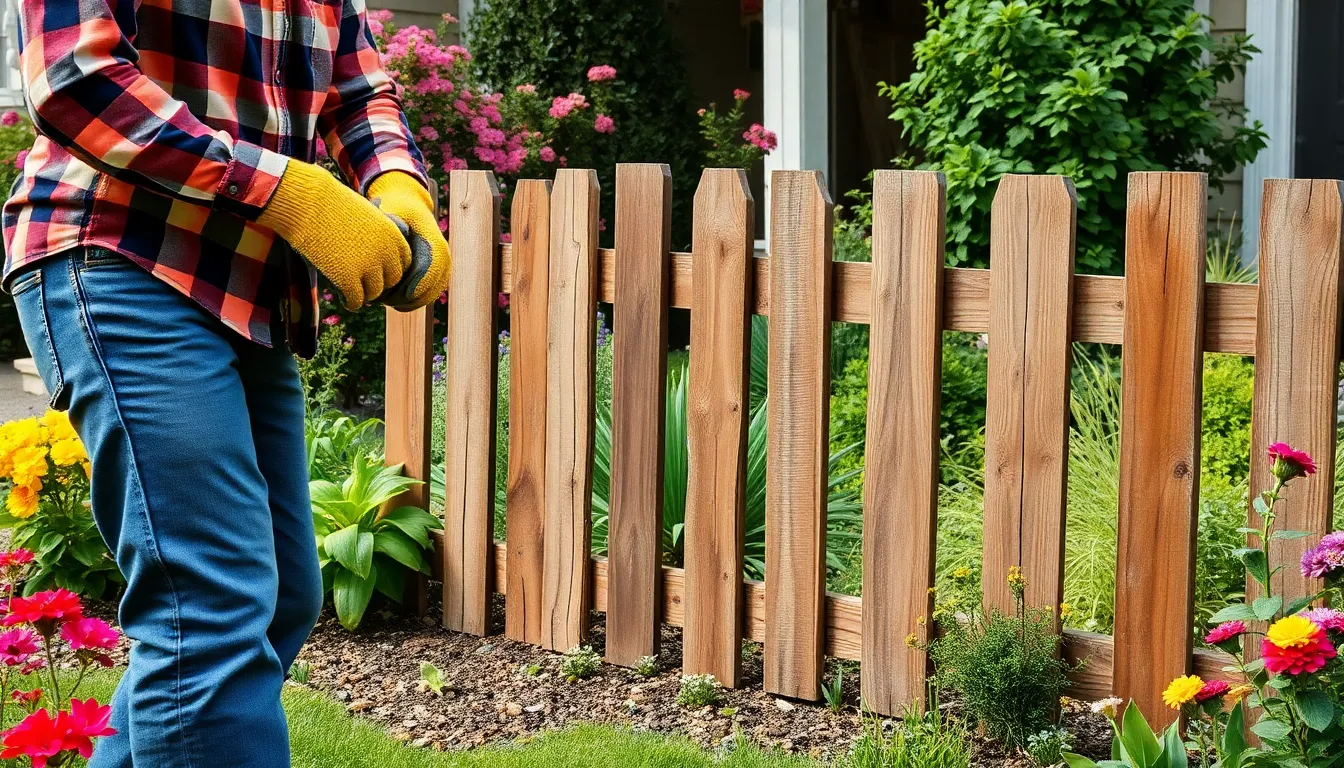
Creating an attractive front garden fence doesn’t require very costly or hiring professionals. We’ve identified the most cost-effective DIY options that deliver impressive results while staying within tight budgets.
Pallet Fence Projects
Pallets offer one of the most accessible DIY-friendly fencing answers for budget-conscious homeowners. We can source these versatile materials from local businesses or online marketplaces at minimal cost, often for free. Deconstructing pallets allows us to use individual boards for custom spacing and height variations. Standard pallet dimensions provide enough material for approximately 4 feet of fencing per unit.
Building with pallets requires basic tools like a crowbar, hammer, and drill for assembly. We recommend sanding rough surfaces and applying weather-resistant stain to extend the fence’s lifespan. Intricate designs become possible by combining multiple pallets or cutting boards into decorative patterns. Installing pallet fences typically takes one weekend for an average front yard perimeter.
Bamboo Screen Answers
Bamboo roll fencing provides exceptional flexibility for unconventional garden shapes and curved property lines. We find this natural material costs significantly less than traditional wood fencing while offering excellent privacy coverage. Thin bamboo slices attached with twine create durable screens that withstand various weather conditions. Rolling installation makes bamboo fencing perfect for temporary or seasonal applications.
Securing bamboo screens requires wooden or metal posts spaced every 6 to 8 feet for proper support. We can customize heights from 3 to 8 feet depending on privacy needs and local regulations. Natural bamboo weathers to an attractive silver-gray color over time, requiring minimal maintenance. Combining bamboo screens with existing industry features creates seamless integration between fencing and garden design.
Recycled Material Options
Recycled corrugated metal panels deliver rustic charm while providing excellent privacy and wind protection for front gardens. We source these materials from construction sites, salvage yards, or renovation projects at fraction of retail costs. Installing metal panels between wooden posts creates industrial-style fencing that complements modern home designs. Weathered patina adds character and eliminates the need for regular painting or staining.
Upcycled pallets transform into attractive fence sections with minimal effort and maximum cost savings. We disassemble pallets to create board and batten styles or use them whole for quick installation projects. Chicken wire combined with wooden posts offers functional perimeter definition for approximately $3 to $5 per linear foot. This combination works especially well for vegetable gardens where visibility and air circulation matter more than complete privacy.
Metal salvage yards provide unique materials like old doors, shutters, or decorative panels for creative fence designs. We recommend treating recycled wood with weather sealant and checking metal components for rust before installation. Mixing different recycled materials creates eclectic fence designs that become conversation pieces while maintaining budget-friendly costs.
Height and Privacy Considerations for Front Yards
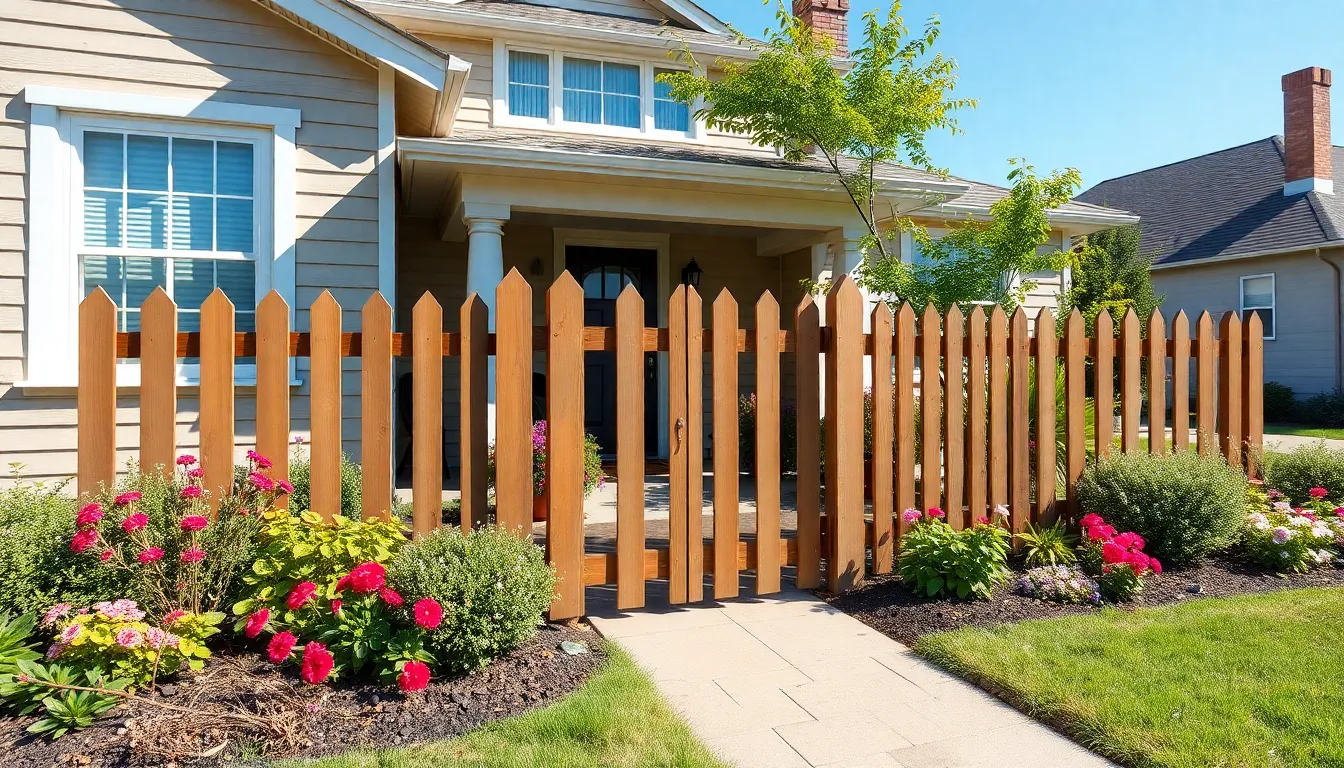
Selecting the right fence height for your front garden requires careful consideration of local regulations and your privacy needs. We’ll explore how to navigate zoning rules while creating an attractive boundary that serves your family’s requirements.
Local Zoning Regulations
Understanding height restrictions is crucial before installing any front yard fence. Most residential areas limit front yard fences to 3 to 4 feet in height to maintain neighborhood visibility and an open aesthetic. Some municipalities allow heights up to 6 feet for privacy purposes, but these exceptions depend entirely on your local zoning ordinances.
Permit requirements often apply to taller fence installations. Many areas require building permits for fences exceeding standard height limits, so we recommend checking with your local building department before beginning any project. The permitting process typically takes several weeks and may include property surveys and neighbor notifications.
Setback rules become increasingly important with fence height. Fences over four feet high must typically be set back from property lines by five feet for each additional foot of height. This regulation prevents towering structures from overwhelming neighboring properties and maintains adequate sight lines for safety.
| Fence Height | Typical Setback Requirement | Permit Usually Required |
|---|---|---|
| 3-4 feet | At property line | No |
| 4-6 feet | 5 feet from line | Yes |
| 6+ feet | 10+ feet from line | Yes |
Balancing Privacy with Openness
Choosing the right fence style helps achieve your desired privacy level without creating a fortress-like appearance. Picket fences naturally allow visibility while defining property boundaries, making them ideal for maintaining neighborhood friendliness. Board on board styles and solid panel designs offer maximum privacy but can feel imposing in front yard applications.
Strategic design elements can enhance aesthetic appeal while preserving openness. We suggest incorporating decorative plants, climbing vines, or artistic panels that add visual interest without creating complete barriers. Alternating panel heights or using semi transparent materials like bamboo screens can provide privacy where needed while maintaining an inviting appearance.
Privacy fences between 4 to 6 feet typically provide sufficient seclusion for front yards. This height range blocks most casual viewing while avoiding the closed off feeling that taller structures create. Consider your exact privacy needs, such as screening ground floor windows or creating intimate seating areas, when determining optimal fence height.
Neighbor Relations and Property Lines
Communicating with neighbors about fence plans prevents disputes and builds goodwill. We recommend discussing your fencing intentions with adjacent property owners before installation begins. This conversation allows you to address concerns, share costs if the fence benefits both properties, and maintain positive relationships throughout the project.
Property line accuracy is essential for avoiding legal complications. Professional surveys ensure your fence installation complies with setback requirements and doesn’t encroach on neighboring properties. Many homeowners assume they know their exact boundaries, but official surveys often reveal surprising discrepancies that could lead to costly relocations.
Shared fence maintenance agreements can benefit all parties involved. When fences sit directly on property lines or serve multiple households, establishing clear maintenance responsibilities prevents future conflicts. Written agreements outlining repair costs, replacement schedules, and aesthetic standards protect everyone’s interests and property values.
Seasonal and Weather-Resistant Fence Materials
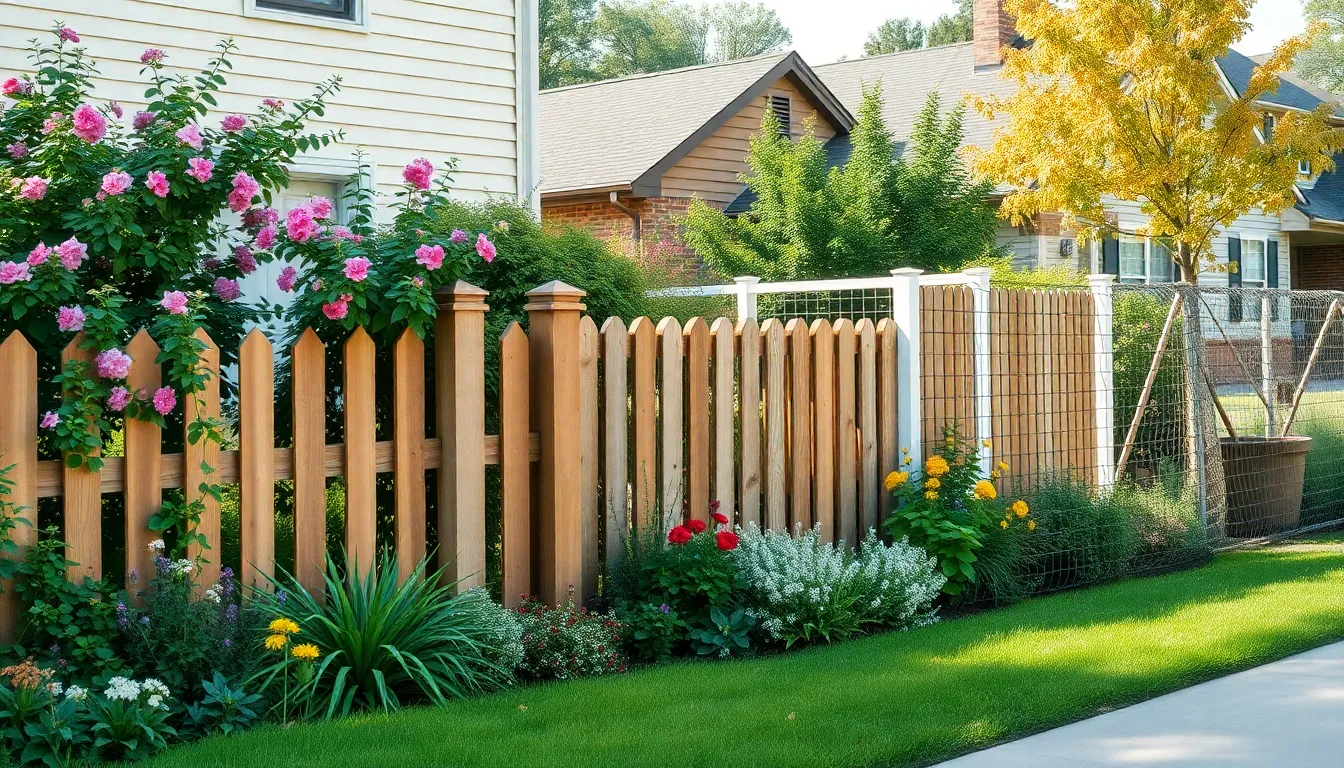
Selecting materials that withstand changing seasons ensures your front garden fence maintains its beauty and function year after year. Different climates demand exact material choices that can handle temperature fluctuations, moisture levels, and UV exposure.
Climate-Appropriate Choices
Cedar, cypress, and redwood naturally resist rot and insects, making them ideal for humid or wet climates where moisture poses the biggest threat to wooden structures. These premium wood options work exceptionally well for traditional picket fences and rustic designs that complement established neighborhoods.
Aluminum, steel, and wrought iron excel in harsh weather conditions where extreme temperatures and precipitation challenge fence durability. Metal materials suit modern horizontal fence designs and can handle everything from scorching summers to freezing winters without compromising structural integrity.
Vinyl fencing requires minimal upkeep while resisting weathering across various climate zones, making it perfect for homeowners who want attractive boundaries without constant maintenance demands.
Hog wire fences thrive in warm climates where year round growing seasons allow plants to weave through panels naturally. This design choice maintains property visibility while creating living walls that evolve with seasonal growth patterns.
Picket fences enhanced with flowering vines work well in temperate climates where moderate temperatures support cottage style aesthetics throughout most of the year.
Weatherproofing Treatments
Waterproof sealants protect wood fences from moisture damage by creating barriers that prevent water penetration into grain structures. Apply these protective coatings every 2 to 3 years to maintain optimal moisture resistance.
Rust resistant coatings prevent metal fence corrosion in areas with high humidity or salt air exposure. These specialized treatments extend metal fence lifespan by 15 to 20 years when applied properly during installation.
UV protective finishes shield fence materials from sun damage that causes fading, cracking, and structural weakening over time. These treatments prove especially valuable in southern climates with intense year round sun exposure.
Stain and paint systems offer dual protection by sealing wood surfaces while adding color that complements home exteriors. Quality exterior grade products provide 5 to 7 years of protection before requiring reapplication.
Long-Term Durability Factors
Material quality directly impacts fence longevity since premium grades resist decay, warping, and structural failure better than budget alternatives. Investing in higher quality materials reduces replacement costs over 20 to 30 year periods.
Regular maintenance prevents minor issues from becoming major repairs through simple tasks like cleaning, tightening hardware, and touching up protective coatings. Annual inspections help identify problems before they compromise fence integrity.
Simple fence designs prove easier to repair and maintain compared to complex styles with multiple components and intricate details. Straightforward construction allows homeowners to handle routine maintenance without professional assistance.
Proper installation techniques ensure structural stability through correct post spacing, adequate concrete footings, and appropriate hardware selection. Professional installation adds upfront costs but prevents premature failure from construction mistakes.
Installation Tips for Front Garden Fence Projects
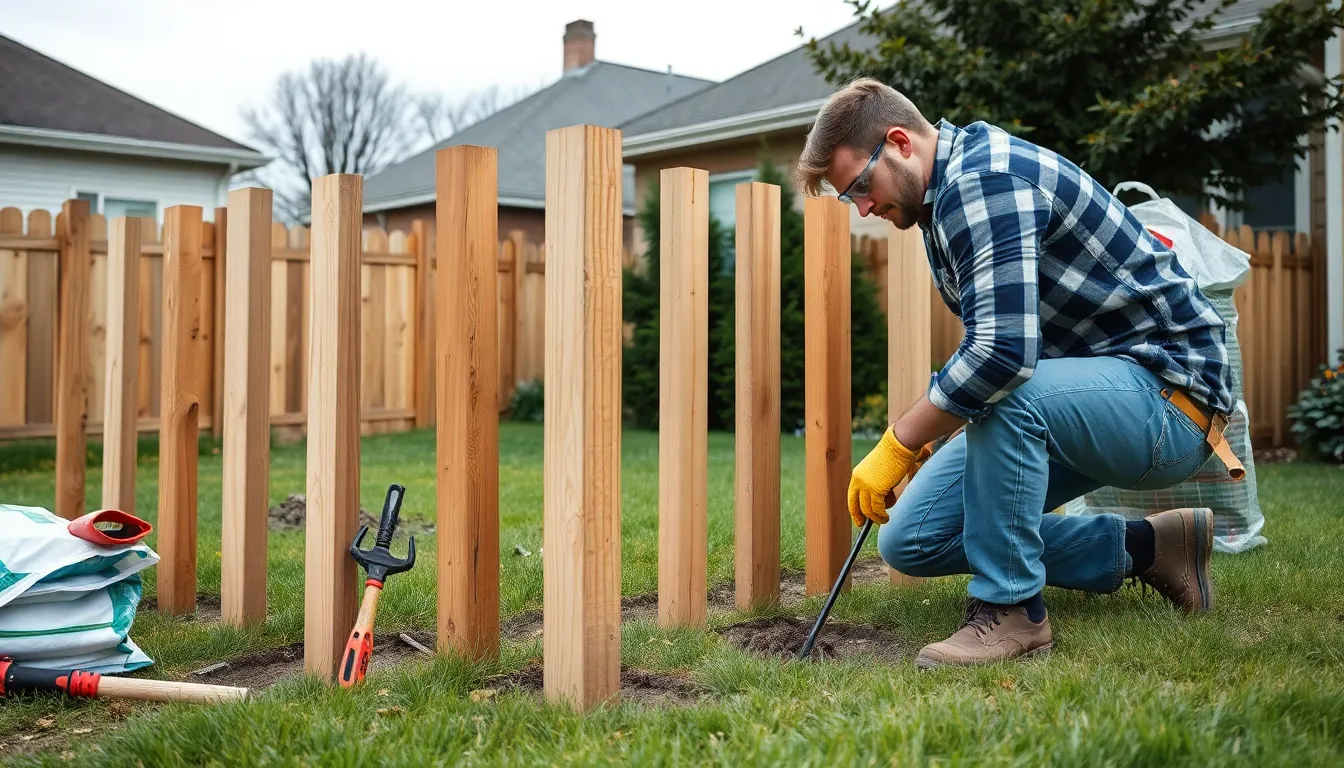
Proper installation techniques determine whether your front garden fence will stand strong for decades or require costly repairs within a few years. We’ll guide you through the essential steps that separate professional quality results from amateur mistakes.
Professional vs. DIY Installation
Professional installation provides a high-quality finish and ensures compliance with local regulations, making it the recommended choice for complex designs or large areas. Contractors bring specialized tools, experience with permit processes, and knowledge of proper foundation techniques that prevent common installation failures. They typically complete projects 50% faster than DIY attempts and offer warranties that protect your investment.
DIY installation suits small projects and homeowners working within tight budgets, requiring careful planning and execution to avoid costly errors. Simple fence styles like basic picket or split rail designs offer excellent starting points for first time installers. We recommend limiting DIY projects to sections under 100 linear feet to maintain manageable scope and quality control.
Budget considerations often drive the decision between professional and DIY approaches. Professional installation costs range from $15 to $40 per linear foot depending on materials and complexity, while DIY projects can cut labor costs by 40% to 60%. But, mistakes in post placement or foundation work can exceed these savings through repair costs.
Foundation and Post Setting
Concrete foundation serves as the essential base for securing posts and preventing shifting or damage over time, with proper techniques determining fence longevity. We recommend digging post holes that reach 12 inches deep for most residential front garden fences, ensuring adequate depth for stability without excessive excavation costs.
Post spacing typically ranges from 8 to 10 feet apart, depending on fence type and local building codes that govern structural requirements. Closer spacing provides additional strength for heavy materials like stone or solid wood panels, while standard spacing works well for lighter options like vinyl or chain link.
Setting posts in concrete requires quick-drying cement to secure placement while ensuring posts remain plumb and level throughout the curing process. We suggest using fast-setting concrete mix that hardens within 20 to 40 minutes, allowing project completion without overnight delays. Check each post with a level in both directions before concrete sets completely.
Rail and panel installation follows post setting, requiring secure attachment to posts with proper alignment and levelness throughout the fence line. Use galvanized fasteners to prevent rust and ensure connections remain tight through seasonal weather changes.
Permit Requirements and Safety
Permits require checking local regulations before starting your front garden fence project, as requirements vary significantly between municipalities and homeowner associations. Most areas require permits for fences exceeding 4 feet in height, while some restrict materials or styles in historic districts or planned communities.
Building departments typically process fence permits within 5 to 10 business days, requiring site plans that show property lines, setback distances, and fence specifications. We recommend submitting permit applications at least two weeks before planned installation to avoid project delays.
Safety measures during installation prevent accidents and ensure proper tool usage throughout the construction process. Always follow manufacturer instructions for materials and wear protective gear including safety glasses, work gloves, and steel toe boots when handling heavy materials or power tools.
Work areas must remain clear of debris to prevent trips and falls, especially important when working with concrete or operating post hole diggers. Keep first aid supplies readily available and ensure someone knows your work schedule when tackling installation projects alone.
Conclusion
We’ve explored an impressive range of front garden fencing options that can transform your property’s curb appeal while meeting your exact needs. From timeless wooden pickets to contemporary glass panels each style offers unique benefits that can complement your home’s architecture and lifestyle.
The key to choosing the perfect front garden fence lies in balancing aesthetics with functionality. Whether you’re drawn to budget-friendly DIY answers or prefer professional installation of premium materials we’ve shown that there’s an option for every homeowner and budget.
Remember to check local regulations and consider long-term maintenance requirements when making your final decision. With proper planning and the right materials your new front garden fence will enhance your property’s value and create an inviting entrance that you’ll enjoy for years to come.
Frequently Asked Questions
What is the ideal height for a front garden fence?
Most residential areas limit front yard fences to 3-4 feet to maintain neighborhood aesthetics and comply with zoning regulations. Some areas allow up to 6 feet for privacy needs. Always check with your local building department for specific height restrictions and permit requirements before installation.
Which fence materials require the least maintenance?
Vinyl and composite fencing offer the lowest maintenance requirements. These materials resist weather damage, don’t need painting or staining, and can last 20-30 years with minimal upkeep. Aluminum and steel are also low-maintenance options that resist rust and corrosion.
Can I install a front garden fence myself?
Yes, many fence types can be DIY projects, especially pallet fences, bamboo rolls, and basic wooden panels. However, professional installation is recommended for complex designs, metal fences, or when permits are required to ensure compliance with local regulations and proper foundation work.
What’s the most budget-friendly fencing option?
Pallet fencing is the most cost-effective option, often using free or low-cost recycled pallets. Bamboo roll fencing and split rail designs are also budget-friendly choices that provide attractive boundaries without significant investment while offering decent privacy and curb appeal.
Do I need a permit for a front garden fence?
Permit requirements vary by location and fence height. Most areas require permits for fences over 4 feet tall or those near property lines. Contact your local building department to understand specific regulations, setback requirements, and permit procedures before starting your project.
Which materials work best in harsh weather conditions?
For harsh weather, choose aluminum, steel, or wrought iron for durability. Cedar, cypress, and redwood naturally resist moisture and insects. Vinyl fencing withstands extreme temperatures without cracking. Apply weatherproof sealants to wood and rust-resistant coatings to metal for enhanced protection.
How do I choose between wood and metal fencing?
Wood offers natural warmth and traditional appeal, with options like cedar and pine. It’s customizable but requires regular maintenance. Metal provides superior durability and modern aesthetics with minimal upkeep. Consider your home’s style, budget, maintenance preferences, and local climate when deciding.
Can I combine different fence materials?
Yes, mixed-material designs create visual interest and functionality. Popular combinations include wood posts with metal panels, stone bases with wooden tops, and hog wire with wooden frames. Ensure materials complement your home’s architecture and maintain design cohesion throughout the fence line.

